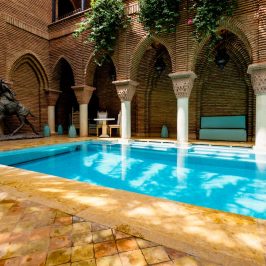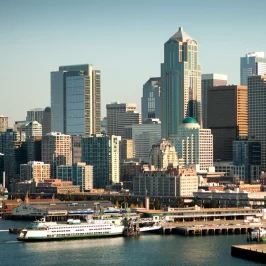What is Salar de Uyuni?
The world’s largest salt flat, also known as Salar de Uyuni, is located in southwest Bolivia and it covers over 4,000 square miles of the Earth’s surface. It is considered one of the most extreme and remarkable vistas in all of South America, if not Earth. It’s the heritage of an ancient lake that went dry, abandoning a desert-like.
Throughout the years, it has become a significant vacation destination – the primary draw being the eccentric point-of-view photographs you can snap on the white salt. It is also known for being a bit tricky to travel to.
Here’s a traveler’s guide to How to Tour Salar de Uyuni – The Largest Salt Desert Of Bolivia, one of the most breathtaking places I have ever been to.
How much does it cost to go to Salar de Uyuni?
I traveled to Bolivia during my five-month backpacking trip across South America in 2019.
For starters, I paid $US160 to get into Bolivia, since US citizens must pay for a visa to enter the country.
How do I get to Salar de Uyuni?
Like many other travelers, I flew into La Paz, the highest capital in the world which lies over 10,000 feet above sea level.
From there, I traveled by bus to Tupiza, a town in southern Bolivia.
I began my tour from Tupiza, a town that looks as if it’s from a beautiful, old Western movie.
The salt flats around there are ensured, so you can’t openly enter them – you should be on a visit. As soon as I arrived in Tupiza, I found plenty of places offering tours to the salt flat.
I didn’t set up a tour ahead of time, so I browsed a few different options for quite a while and selected the one that seemed the best for me.
Start My Four-day Tour to Salar de Uyuni
I ended up paying roughly $US195 for my ticket and began my four-day tour to Salar de Uyuni the next day.
Getting to the salt flat was a serious adventure that included numerous long periods of driving.
I jumped in an eight-seat, four-wheel-drive Land Rover and began my shared tour with three other travelers.
The tour company I used also brought along an English-speaking guide, a cook, and a driver.
We began the tour with three days of driving across Bolivian Altiplano to end in Salar de Uyuni on the fourth and final day.
Along the way, I got to see and experience Bolivia’s incredible landscape.
For the first three days of the tour, we drove up to 10 hours per day.
Our meals were provided by and prepared by the cook and we stayed in simple accommodations, including a hotel made entirely from salt.
What I Explore on the Way to Salar de Uyuni
Along the way, we stopped in plenty of beautiful places.
The first day of the drive was tough because we drove up in elevation for about eight hours since the salt flat was about 12,000 feet above sea level.
I drank tons of water since it’s important to stay hydrated in order to ward off altitude sickness.
On the second day, we jumped in hot springs, took photos at Laguna Verde, a famous green-colored lake, and watched geysers spring from the earth.
We also saw a red-colored lake.

Photo Credit: Travelbusy.com
On the third day, we visited Laguna Colorada, a famous shallow lake, and Árbol de Piedra, an isolated rock formation.
We saw animals, too.
We also halted by Lagunas Altiplanicas, where we recognized a couple of various types of pink flamingos. By the fourth day, we had arrived at Salar de Uyuni.

Photo Credit: Pedro Szekely
We woke up at about 4 A.M. On the final day of the tour, we drove an hour across the salt flat to get to a place called Isla Incahuasi (Cactus Island) so we could watch the sunrise.

Photo Credit: sandeepachetan.com travel photography
The island is a little hill on Salar de Uyuni filled with thick, giant cacti. We got to the top of it just in time for the sun to rise and shine on the pure white salt flats.
To get into the island area, I had to pay an entry fee that came to about $US4.33, but it was totally worth it.
What is the best time to visit Salar de Uyuni?
The salt flat is known for resembling a mysterious ocean of mirrors — yet it doesn’t appear as though that all year. I visited during the dry season, so I didn’t experience the magical reflective effect firsthand.
The mirror effect of the salt flat happens during the wet season, which is from around December or January to April.
During these months, a slender layer of water covers the outside of the salt, which makes it resemble an ideal mirror in perspective photographs. I visited Salar de Uyuni during November, which is part of the area’s dry season.
At the point when I visited in November, the salt level resembled a sheet of fresh snow, it was crunchy to touch.
Even though the salt was not quite as cold as snow, it was winter when I visited and it was quite chilly so I wore as many warm layers as I could.
Visiting during the dry season did not hinder my experience – in fact, I think it’s better to go during this time because visitors can access more areas of the landscape and there’s less of a risk of tours getting canceled due to excessive rain (which is common).
How to take photos in Salar de Uyuni?
We had two hours to take photos of the salt flats.
After we arrived, the tour guide took us over to the salt flat so we could take pictures in an increasingly detached spot. Here, we had about two hours to be goofy and snap tons of perspective photos.

Photo Credit: Geee Kay
To get the perfect shot, the photographer must get low to the ground.
For some photos, the props (toy dinosaurs, boots, and soda bottles) should be close to the camera, while the model is farther away in the background.
You can also do the reverse, standing close to the camera and moving props far away, which might make you look like a giant.
It took us a few tries to get this perspective thing just right, but once we did, it was super fun to pose and snap photos.
Taking pictures was particularly cool since we had a group of individuals to work with.
We did a couple of theatrical videos, such as having one person pretend to be a giant while they chasing the rest of the group, or having the group pretend to walk on a tightrope between two shoelaces.
Where to Stay in Salar de Uyuni?
We stayed in Hotel Palacio de Sal. This lodging is a desert spring in the Salar de Uyuni zone. The Hotel Palacio de Sal is situated on the banks of the grand Salar de Uyuni in Bolivia, only 25 km from the city of a similar name, special in its group for being completely worked with salt: dividers, floors, roofs, furniture, figures … everything!.
Driving up to the lodging, the veneer is amazing. Within is well-designed and warm.
We moved up to a suite with a seating zone, restroom, and dozing zone. The beds were OK with a warm cover. The shower was pleasant and hot. Our solitary grumbling was the washroom entryway was somewhat difficult to open.
The café was made up to be extravagant. Very much delegated with polite staff. Nourishment, while not gourmet, was acceptable, new, and copious.
I was truly delighted in it remaining here and wished we could have gone through the following night here rather than at Tayka de Desierto. It’s such a pleasant respite from the long, dusty, and rough streets in the region.
My just and minor concern is that there are no wardrobes or drawers to put garments, so one needs to live out of the bag or put garments and so on the floor.
Some Important Tips You Need to Know
It was such a breathtaking experience to be on the salt flat.
I could look for miles and not see anything but a flat, white surface. I found it to be peaceful, stunning, and extraordinary.
I’m really happy I brought my sunglasses since the white was fantastically bright. That said, I wish I knew a few things before I went.
I wish I knew how cold it was going to be at night in this part of Bolivia since temperatures dropped well below freezing and our accommodation on the tour didn’t have heaters.
If I were to do this again, I would bring a really warm jacket.
I also wish I had brought more props for photos, but I am glad I wore black.
I realized later that a ton of voyagers bring toys, for example, dinosaur dolls, to use as props. We weren’t prepared for this, and we only had a bottle of wine and a jar of Vegemite.
Still, they made for some hilarious photos.
I’m really happy I wore dark attire since it appeared to truly fly against the white and blue background of the spot.
All in all, this was a once-in-a-lifetime experience that I am glad I did.
I had a wonderful adventure to and on this famous Bolivian salt flat and I’m glad I did my research about tours before I went.
All in all, whether you visit during the wet season or dry season, Salar de Uyuni will surely take your breath away.
What is Salar de Uyuni?
It is the world’s largest salt flat located in Bolivia, covering over 4,000 square miles.
How do I get to Salar de Uyuni?
Most travelers fly into La Paz, followed by a bus ride to Tupiza where the tours start.
What is the best time to visit Salar de Uyuni?
The dry season (November) offers more accessible areas, while the wet season (December-April) provides the famous mirror effect.
How much does it cost to tour Salar de Uyuni?
A typical four-day tour costs around $195, plus additional entry fees.
What should I pack for a tour to Salar de Uyuni?
Warm clothing, sunglasses, and props for photos are essential.
What can I see on the way to Salar de Uyuni?
Along the way, you can see lakes (Laguna Verde, Laguna Colorada), hot springs, and flamingos.
How do I take perspective photos of the salt flats?
Use props and position yourself creatively to play with depth perception.
Where can I stay when visiting Salar de Uyuni?
The Hotel Palacio de Sal is a popular choice, entirely built of salt.
Is it safe to travel to Salar de Uyuni?
Yes, but be prepared for long drives, altitude, and cold nights.
Do I need a visa to enter Bolivia?
Yes, U.S. citizens, for example, need to pay around $160 for a visa.
Like this article? Share this with your travel buddies and pin it if you are on Pinterest.


Are you looking for more practical information about Bolivia? Make sure to check these posts as well:
- Discover Bolivia
- Top 10 Things to Do in Bolivia: Discover the Unusual Attractions
- Bolivia’s Hidden Retreats: Unveiling the Best Hotels and Accommodations









